![]()
![]()
![]()
Use LEFT and RIGHT arrow keys to navigate between flashcards;
Use UP and DOWN arrow keys to flip the card;
H to show hint;
A reads text to speech;
98 Cards in this Set
- Front
- Back
|
Where does Carb Digestion take place in Monogastrics? |
Oral cavity Stomach Small Intestines |
|
|
Describe oral digestion in monogastrics (2).. |
Mastication - decrease particle size and increase area for enzyme digestion
Salivary amylase - converts startch to maltose and smaller oligosaccharides (minor in pigs&dogs) |
|
|
Describe carb digestion in the stomach of monogastrics... |
Corpus and fundus -Salivary amylase converts starch to maltose and small oligosaccharides (esp. pigs) -enzyme inactivated with low pH |
|
|
Describe carb digestion in the intestine of monogastrics.. |
-Pancreatic amylase converts remaining starch and polysaccharides to monosaccharides |
|
|
What are the 2 phases of carb intestinal digestion? |
Luminal phase - enzymes active in gut lumen Membranous phase - Enzymes active on surface of the gut |
|
|
What happens in the Luminal phase of intestinal digestion? |
-large polymers (starch, protein) -Digestive enzymes from salivary, gastric, and pancreatic glands =breakdown to smaller polysaccharides |
|
|
What happens in the membranous phase of intestinal digestion? |
-small polymers (polysaccharides, peptides) -Digestive enzymes synthesized in enterocytes and attached to apical membrane = breakdown to peptides (monomers for absorption) |
|
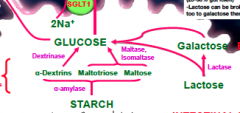
Steps of intestinal starch digestion Pancreatic phase (breaking polysaccharide down)... |
**some salivary amylase starts break down**
1. a-alymase is secreted 2. Breaks down large polysaccharides into smaller oligosaccharides (breaks a-1,4 linkages) 3. Dextrinase, Maltase, Isomaltase are secreted 4. Brush boarder breakdown of a-dextrins, maltotriose, and maltose to monosaccharides (glucose) |
|

Steps of intestinal starch digestion Mucosal phase (continued breakdown and uptake)... |
1. Monosaccharides are picked up by Na+ glucose like transporter (SGLT1) 2. Then secreted by GLUT 2 into portal circulation OR used for gut metabolism 3. Na+ recycled with ATPase 4. Liver (DELIVERY PHASE)
**HIGH concentration of glucose can pass directly though paracellular groove |
|
|
What can lactose be broken down to? |
-Galactose then glucose by lactase |
|
|
What are the enzymes that inhibit starch hydrolysis and glucose uptake? |
a-glucosidase inhibitors -acarbose, miglitol |
|
|
Sodium-glucose co-transporers: SGLT1 and SGLT2
What tissues are they found on and what are their functions? |
SGLT1 -Kidney, intestine -Glucose reabsorption in intestine and kidney
SGLT2 -Kidney -Low affinity - high selectivity for glucose
**SGLT3 is on SI and skeletal muscle for glucose activated Na+ channel |
|
|
Facilitative glucose transporters - GLUT1, GLUT2
Major tissues and functions? |
GLUT1: ubiquitous (RBC, Brain, eye, mammary) -basal glucose uptake -transport across blood tissue barrier
GLUT2: Liver, kidney, pancreas, SI -High capacity low affinity transport
|
|
|
Facilitative glucose transporters - GLUT4, GLUT5
Major tissues and functions? |
GLUT4: Muscle, Fat, Heart -insulin regulated transport in muscle and fat
GLUT5: Intestine, kidney, testis -Fructose transport
|
|
|
When does paracellular diffusion of intestinal sugar absorption happen? ('solvent drag') |
High luminal glucose concentrations (>25mM) |
|
|
What are the 2 types of active transport for intestinal sugar absorption? |
1. Facilitative Transport (GLUT 1-12) -fructose tranport (GLUT5) - limited in ruminants
2.Sodium dependent glucose transport (SGLT1-3) -high affinity, low capacity -throughout GI tract (increased in jejunum) -1 glucose + 2 H2O for 2Na+ -rapidly inducible by glucose (high grain)
|
|
|
What are some species adaptations for intestinal sugar absorption? |
- Dogs expression of SGLT1 and disaccharidases (sucrase, maltase, lactase) and absorption is greater than CATS
-Ruminant Digestion efficiency: SI (97%) > LI (80%) > rumen (60%) |
|
|
Where does Carbohydrate digestion (fermentation) take place in ruminants? |
Foregut (reticulo-rumen and abomasum)
Hindgut (cecum and colon)
|
|
|
What is the main role of carbs in ruminants? |
Energy for microbes (rumen, cecum and colon) and host -maintain healthy GI tract! |
|
|
What are the products of fermentation? |
-FEED -> microbes -> VFA + CH4 + CO2 + microbial cells + long chain FA |
|
|
What are the types of VFA? |
-Acetate -Propionate -Butyrate (isobutyrate, isovalerate, 2-methyl butyrate) |
|
|
What are the 4 digesta fractions in the rumen? |
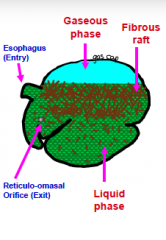
1. Fibrous raft - highest density of microbes 2. Liquid fraction - shuttles saliva and fermentation end product in and out 3. Boundary layer against lumen surface - bidirectional fluid exchange 4. Soupy material (ventral and cranial sacs) - cud and material for omasum |
|
|
What is fermentation? |
Slow digestive process of anaerobic digestion by microbial enzymes
|
|
|
Location of fermentation for foregut fermentation vs hindgut fermentation? |
Foregut = reticulrumen (ruminants, camels)
Hindgut = cecum, colon (horses, rabbits) |
|
|
Explain the synergy between the host and microbes in fermentation.. |
Host: provide environment -substrate, H2O, pH, oxidation-reduction conditions, slow digesta flow)
Microbes (bacteria, protozoa, fungi) -convert indigestible material into usable products -VFA, CH4, NH4, CO2, microbial cells, Long chain FA |
|
|
What are the requirements for fermentation (5)? |
1. Substrate - regular supply 2. Microbes - suitable numbers & types (removal comparable with regeneration) 3. Mixing/propulsion - add new substrate & buffers, move contents to abomasum and present inhibitory end product accumulation 4. Fermentation end products - steadily removed 5. Stable intraruminal conditions |
|
|
What are the stable intraruminal conditions required? |
1. optimum temperature (37) 2. osmolality 300 mOsm 3. pH ~6.4 4. Anerobic conditions -negative oxidation-reduction potential |
|
|
What do rumen protozoa do to aid in digestion and fermentation? |
1. Engulf feed particles, digest and store CHO, proteins, and fat 2. Ingest bacteria (keep in check) 3. Produce SOME VFA and NH3 4. Slow down digestion of rapidly fermentable starches and proteins 5.Decrease with high grain diet (pH <5.5) |
|
|
What are the advantages of having rumen protozoa? |
1. Store starch particles - preventing rapid starch degradation by amylolytic bacteria 2. Reservoir of microbial protein at times of scares/poor feed 3. Digested = provide host with protein, starch and PUFA |
|
|
What are the types of rumen bacteria based on location? |
1. Free living in Liquid phase 2. Loosely/firmly associated with feed particles 3. Associated with rumen epithelium 4. Attached to surface protozoa and fungi |
|
|
What are the types of rumen bacteria based on fermentation? |
1. Primary bacteria (feed on digesta) -cellulolytic: 18h to double (slow metabolism) -Amylolytic: <4h to double (pH 5.5-6.6) (fast)
2. Secondary bacteria (feed on byproducts) - 16h to double (pH 6.2-6.8) -Propionate bacteria = utilize lactate -methanogenic bacteria = utilize H2 |
|
|
Explain the process of bacteria attached to plants? |
1. free bacteria move to fibrous substrate 2. Initial non specific adhesion (electrostatic/ionic) on cut/macerated surfaces 3. Specific adhesion (ligands on bacteria) = proliferation and colonization on feed |
|
|
What happens to cellulose digestion if unsaturated fat is fed? |
DECREASE in digestion of cellulose!! (kills bacteria) |
|
|
What are the benefits of bacterial attachment to plants? |
1. Brings enzymes and substrate together 2. Protects enzymes from proteases 3. Allows bacteria to colonize the digestible surface of feed 4. Retention in the rumen to prolong digestion 5. Reduces predatory activity of protozoa |
|
|
Protozoa... Function Storage Location # and size pH sensitivity |
Function: digestion and storage of starch and fat particles -feed on bacteria -produce VFA, CO2 and NH3 Storage: feed particle to delay digestion Location : Both liquid and solid phases # and size: 10^4-10^6 cell/gm rumen (~51%) pH sensitivity: highly sensitive (die in grain) |
|
|
Bacteria... Function Storage Location # and size pH sensitivity |
Function: fermenting CHO, fat, protein to VFA CO2 and NH3 Storage: Very limited to none Location: Free living phase, loosely attached to feed, protozoa and fungi attached # and size: 10^10-10^12 cells/ gm rumen (48%) pH sensitivity: some are pH resistant |
|
|
Carb digestion ruminants |

-creates VFA and intestinal glucose -VFA absorbed for VFA metabolism OR glucose synthesis -Glucose is absorbed **Products used for energy metabolism |
|

How are VFA's made: Stage 1 (polysaccharide hydrolysis)... |
Starch (amylolytic bacteria pH >5.5) -> glucose Cellulose (cellulolytic bacteria pH > 6.2) -> glucose GLUCOSE => fructose 1,6 BisP
Fructosans -> fructose -> fructose 1,6 BisP
Hemicellulose + Pectin -> xylose -> fructose 1,6 BisP |
|

How are VFA's made: Stage 2 (Glycolysis) |
fructose 1,6 BisP -> phosphoenopyruvate (glycolysis)
phosphoenopyruvate (glycolysis) -> -FORMATE -ACETATE -PYRUVATE |
|
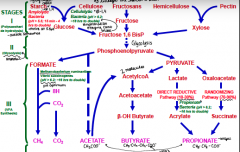
How are VFA's made: Stage 3 (VFA synthesis) |
FORMATE -> CH4 and CO2
ACETATE -> Acetyl CoA -> Acetoacetate -> B-OH Butyrate -> BUTYRATE
PYRUVATE -> 1. Acetyl CoA -> Acetoacetate -> B-OH Butyrate -> BUTYRATE 2. Lactate -> [direct reductive pathway - propionate bacteria pH >6.2] -> Acrylate -> PROPIONATE 3. Oxaloacetate -> [Randomizing pathway (70-90%)] -> succinate -> PROPIONATE |
|
|
How are VFA's made: Stage 4 |
Microbial (protein) synthesis using stages 1-3 intermediates!! |
|
|
What bacteria digests starch? |
Amylolytic -pH >5.5 -15 min - 4h doubling |
|
|
What bacteria digest cellulose? |
Cellulolytic bacteria -pH>6.2 -18h to double
|
|
|
What bacteria is involved in the direct reductive pathway to acrylate (propionate synthesis)? |
Propionate bacteria -pH >6.2 -16h double |
|
|
VFA production vs Forage Concentration -Increasing Concentrates, Decreasing forages |

Increases -total VFA production -Propionic acid production (Propionate bacteria)
Decreases -Acetic acid (methanobacterium ruminantium)
**Butyric acid stays the same |
|
|
Milk production and composition vs Forage Concentration -Increasing Concentrates, Decreasing forages |

Milk production increases
Fat in milk stays steady till pH <6.0 then drops |
|
|
As grain concentration increases what does pH do? |
Decreases (acidic) Range = 6.5 -> 5.0 |
|

How are VFA's absorbed - entry into epithelial cell...? |
1.Diffusion of undissociated short chain fatty acids (HSCFA) -lipophillic acids (ie. butyric) = efficient -Acids release protons once inside cell 2.SCFA (acetic, propionic, butyric) transportors -anions (SCFA-) for HCO3- for apical uptake -important for less lipophilic acids (acetate) 3.Lactates anions can enter the cell in co-transport with their protons |
|
|
What mainly drives SCFA transporters and how? |
HCO3- -imported from the blood via Na+/HCO3- cotransport -apically-exported HCO3- neutralizes one H+ in the rumen = CO2 + H2O |
|
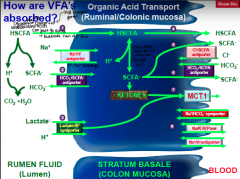
How are VFA's absorbed - exit from epithelial cell (to blood)...? |
1. Diffusion of lipophilic and undissociated HSCFA 2. Anion channel permeable to large anions (Cl-) like SCFA- (Cl-/SCFA- antiporter) 3. SCFA-/HCO3- exchanger 4. Metabolized ketone bodies, lactate expelled with protons via monocarboxylate transporter 1 (MCT1)
|
|
|
How VFA's are absorbed... the last step is removing H+... How is this done? |
H+ taken up with HSCFA or lactic acid = neutralized by HCO3- from basolateral Na+/HCO3- cotransport = expelled by Na+/H+ exchange (apical or basalateral) =ATPase on basolateral provides energy form Na+ driven transport |
|
|
What is butyrate and propionate metabolized to during VFA absorption inside cells? |
90% Butyrate = kentone bodies (BHBH & acetoacetate) = alimentary ketogenesis
70% Propionate = lactate + CO2 + AA
30% acetate metabolized (fast absorption) |
|

Referring to the % dissociated VFA's, what happens when the rumen pH goes up? (pKa=4.8) |
MORE [H+] + [A-] -Dissociated -Charged -Unprotonated -Free -Conjugate base (H+ acceptor) -'Acetate' form -SLOWLY ABSORBED (some active)
**NORMAL!! |
|
|
Referring to the % dissociated VFA's, what happens when the rumen pH goes down? (pKa=3.9) |
MORE [HA] -Undissociated -Uncharged -Protonated -Bound -Conjugate acid (H+ donor) -'Acetic Acid' form -RAPIDLY ABSORBED (diffuses across rumen) |
|
|
What are the precursors for acetate, butyrate, and propionate? |
Acetate = Phosphoenol pyruvate Butyrate = Acetyl CoA Propionate = oxaloacetate and lactate |
|
|
What are the relative proportions for VFA production in a high forage diet vs high grain? |
High forage = A>P>B
High grain = P>A>B |
|
|
Does HSCFA or H+ + SCFA- have rapid absorption? Which has slow? |
HSCFA = RAPID H+ + SCFA = SLOW |
|
|
What % VFA absorption is in the rumen, omasum, intestine? |
Rumen = 70% Omasum = 20% Intestine = <10% |
|
|
Order lactate, acetate, propionate, and butyrate from slowest absorption to fastest... |
lactate < acetate < propionate < butyrate |
|
|
What is the fate of VFA acetate after absorption (metabolism)? |

Acetate -> Acetyl CoA... 1. Krebs cycle -> energy (10ATP/mole) 2. FA -> Lipids
**energy and fat synthesis** |
|
|
What is the fate of VFA propionate after absorption (metabolism)? |

Propionate -> propionyl CoA (lactate) -> Methyl malonyl CoA -> Succinyl CoA -> Krebs cycle -> 1. Glucose 2. Energy (18 ATP/mole)
**make glucose, lactate and energy** |
|
|
What is the fate of VFA butyrate after absorption (metabolism)? |

Butyrate -> Butyryl CoA (FA synthesis mammary) -> BHBA -> Acetyl CoA -> Krebs cycle -> Energy (27ATP/mole)
**FA and energy synthesis** |
|
|
What does acetate get used for? |
-energy (30% metabolized in rumen epithelium) -Carbon source for FA - adipose & mammary -not used for net glucose (no effect on insulin) |
|
|
What does propionate get used for? |
- Energy (70% metabolized in rumen epithelium) - Precursor of glucose (stimulates insulin) -5% to lactate |
|
|
What does butyrate get used for? |
-Energy (90% converted to BHBA in rumen epithelium) -Carbon sourse for FA - mammary -Not glucose synthesis, but stimulate secretion of insulin and glucagon -Critical for rumen papillae growth (young calves) |
|
|
Increased grain diet does what to the rumen papillae? |
-Increased fermentable carbs causes SLOUGHING of the stratum corneun = excessive keratinization of epithelium
**PARAKERATOSIS = decreased absorption |
|
|
Rumen acidosis - grain fed animals 90-95% of cultural bacteria are what type? |
Amylolytic bacteria |
|
|
Rumen acidosis - What are the bacteria that rapidly ferment starch/soluble sugars? |
-Selenomonas ruminatium -Streptococcus bovis -Lactobacillus
|
|
|
Rumen acidosis - What type of bacteria is the dominant organism in the rumen? |
-S. ruminantium |
|
|
Rumen acidosis - what type of bacteria is a faculative anaerobe but has explosive growth in response to fermentable carbs (esp. animals unadapted to grain)?
**doubling time of ~12minutes |
-S. bovis |
|
|
Rumen acidosis - What does the lactic acid produced by S. bovis do? |
-decreases ruminal pH =inhibits the growth of most ruminal bacteria =acid tolerant lactobacilli become dominant |
|
|
Rumen acidosis - What type of bacteria are predominant in the acidotic rumen (pH 5.6)? |
-Lactobacilli runimis (produces L (+) lactic acid) -Lactobacillus vitulinus (produces D (+) lactic acid)
|
|
|
Rumen acidosis - What do lactobacilli do? |
-increase lactic acid producing bacteria -Decrease lactate utilizing bacteria like M elsdenii and S ruminatium
|
|
|
Rumen acidosis - What are some things that happen due to acidosis? |
-Rumenitis (ulcers) -Liver abscesses (F. necrophorum) -Diarrhea (increase osmolality of rumen fluids) -Laminitis -Death from dehydration, acidosis or endotoxemia |
|
|
Rumen acidosis - Process of lactic acid production... |
1. Increase in fermentable CHO (pH>6.2) 2. Increase Growth Rate of amylolytic, cellulolytic, methanogenic, propionibacteria, S.bovis, Lactobacillus) 3. Increased VFA production 4. Decreased pH (5.5-6) 5. Increased S. Bovis growth rate (&Lactobacillus) 6. Increased Lactic acid |
|
|
Rumen acidosis - What does increased lactic acid do? |
-Decreases pH -D/L lactic acid absorbed |
|
|
Rumen acidosis - What does the decreased pH do to the growth rate of bacteria? |
- decreases the growth rate which... -decreases pH more (<5.5) == INCREASED lactobacillus increases lactic acid ==Decreased S. Bovis |
|
|
Rumen acidosis - What does the decreased pH do to the RR epithelial receptors and boucle receptors? Which then causes what? |
- persistent activation of RR epithelial receptors -decreased excitation of buccal receptors 1.Inhibition of brain stem, gastric, and salivary centres (decrease bicarb) 2. Stasis in fermentation (decreased motility) 3. D/L lactic acid absorbed 4. METABOLIC ACIDOSIS!!!!
|
|
|
Rumen acidosis - image |
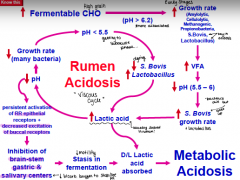
|
|
|
Energy can be formed by what 3 things? |
Carbohydrates - glycolysis, glycogenesis, glycogenolysis Lipids - lipid transport, lipogenesis, lipolysis, B-oxidation Proteins - AA metabolism, Ureagenesis |
|
|
How is ATP formed from carbs? |
1. transport glucose into the cell 2. Glycolysis to pyruvate (aerobic) or lactate (anerobic) 3. TCA cycle and oxidative phosphorylation via ETS = 36ATP/glucose |
|
|
How is ATP formed from FA? |
1. Transport to mitochondria 2. B-oxidation to acetyl CoA 3. TCA cycle and ETS = 129 ATP?palmitate molecule |
|
|
How is ATP formed from AA? |
1. Transamination to generate carbon-skeletons 2. Ketone bodies enter TCA cycle and ETS |
|
|
Glycogenesis in the liver- process? |
1. Lactate (blood or muscle to liver) to pyruvate 2. Pyruvate to glucose (gluconeogenesis) 3. Glucose to glucose-6-phosphate to glucose-1-phosphate 4. converted to LIVER GLYCOGEN with glycogen synthase |
|
|
Glycogenolysis in liver - process |
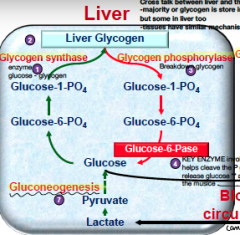
1. Liver glycogen to glucose-1-phosphate (via glycogen phosphorylase) 2. to glucose-6-phosphate 3. to GLUCOSE (via glucose-6-Pase)
**then can exit liver to go to blood and potentially muscle** |
|
|
Glycogenesis in muscle -process... |
1. Glucose from the liver to glucose-6-phosphate 2. to glucose-1-phosphate 3. to MUSCLE GLYCOGEN via glycogen synthase
|
|
|
Glycogenolysis in muslce - process... |

1. Muscle glycogen to glucose-6-phosphate (via glycogen phosphorylase) 2. to glucose-1-phosphate 3. to pyruvate and ATP (glycolysis) 4. pyruvate to lactate
**lactate can enter the liver to make glucose** |
|
|
Glycogenesis-glycogenolysis in muscle and liver - what are the rate limiting enzymes? |
Glycogenesis = glycogen synthase
Glycogenolysis = glycogen phosphorylase and glucose-6-phosphatase (absent in muscle) |
|
|
Glycogenesis-glycogenolysis in muscle and liver - what is used for ATP synthesis in muscle but not liver? |
Glucose-6-phosphate |
|
|
What is the Cori cycle? |
1. Lactate from muscle 2. Transported via blood to liver 3. Gluconeogenesis from lactate in liver 4. Glucose returned to muscle via blood |
|
|
What are the glucose requirement for ruminants? Plasma glucose Energy source Fat synthesis Pregnancy and lactation
|
Plasma glucose: 50-60mg/dl Energy source: CNS, RBC Fat synthesis: NADPH, Glycerol Pregnancy and lactation: Fetal energy, lactose synthesis |
|
|
What are the sources for gluconeogenesis (glucose) for ruminants? |
Propionate AA Lactate Glycerol |
|
|
How much of the glucose needs doe gluconeogenesis meet in ruminants? |
-75-90% of total glucose (occurs at all times) |
|
|
Where do carnivores get the source for gluconeogenesis?
What is their plasma glucose?
|
AA
-plasma glucose 100mg/dl |
|
|
During anaerobic exercise where does gluconeogenesis get its source from? |
Muscle lactate from cori cycle |
|
|
What are the 4 principle types of hypoglycaemia? |
1. Insufficient gluconeogenesis and glycogen stores - esp. ruminants and neonatal pigs 2.Mesenchymal tumors -inhibition of glucagon 3.Glycogen storage disease 4.Hyperinsulinemia
|
|
|
What is hyperinsulinemia (Somogyi overswing phenomenon)? |
-Insulin overdose causing hypoglycemia = increase glucagon and cortisol secretions = HYPERGLYCEMIA and glucosuria -Organic (tutor of islets) or functional (over secretion of insulin) hyperinsulinism (dogs) |
|
|
What are the 2 types of diabetes? |
1. Type 1 (juvenile) -primary insulin deficiency (B-cell failure, autoimmune) -Dogs and cats 2. Type 2 (adult onset) -Primary insulin resistance (B-cell exhaustion and atrophy) -Cats, early lactation cows 3. Gestational Diabetes 4. Diestrus diabetes |

